Victoria is situated in south-eastern Australia. Its capital city is Melbourne.
- The history of Victoria
- Victoria by numbers
- State flag and emblems
- Victoria attractions
- Victoria fast facts
- References
The history of Victoria
Indigenous history
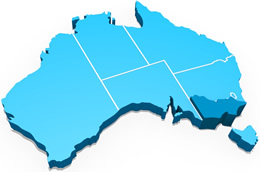
Before the arrival of Europeans, Victoria was home to over 30 Indigenous language groups. These language groups were each made up of many communities such as the Wemba Wemba, Yorta Yorta, the Gunai Kurnai (from the Gippsland area) and the Kulin Nation (of central Victoria).
Aboriginal people in Victoria used rock, bark, wood and sand as mediums for painting, carving and drawing. Rock art records dreaming stories, depicting humans, animals and other designs. Art was, and still is, important to Aboriginal life in Victoria.

European arrival
The Englishman Lieutenant David Collins first arrived in Australia with the First Fleet in 1788. The First Fleet was made up of 11 ships carrying British convicts and their officers. After returning to England for a time, Lieutenant Collins ventured to the Port Phillip district (present-day Victoria) in 1803, where he attempted to settle a new penal colony. The free settlers and the marines were not happy with this location, so Victoria was abandoned and Lieutenant Collins moved on. Eventually, in 1804, he settled instead in Hobart, Tasmania (then known as Van Diemen’s Land).
Members of the Henty family were the first European settlers to settle in Victoria, arriving in Portland Bay in 1834. They had previously settled in Western Australia and Tasmania, but after unsuccessful attempts at farming they moved to Victoria.
Although the Henty family were certainly the first settlers in the Victorian countryside, it is arguable whether it was John Batman or John Pascoe Fawkner who settled Melbourne. John Batman arrived in Port Phillip in 1835 and sought out the local Indigenous leaders in an attempt to buy their land. John Fawkner’s ship arrived in Port Phillip three days before his rival, although he himself was held up in Launceston. Fawkner eventually established Melbourne’s first pub, hotel and newspaper.
The first immigrant ship arrived in Port Phillip in 1839; and in 1851 Victoria separated from New South Wales. During the 1850s gold was discovered in Victoria creating a gold frenzy. The Gold Rush brought large numbers of settlers to Victoria hoping to make their fortune. Instead they were met by the often horrible conditions in the goldfields where, for most, gold and wealth were more myth than reality.

Victoria by numbers*
- The total population of Victoria is 6,244,200.
- Melbourne (the capital city of Victoria) has an estimated population of about 4.67 million people.
- 49.2 percent of Victorians are male and 50.8 percent are female.
- Aboriginal and Torres Strait Islanders account for 0.8 percent of the Victorian population.
- The top five ancestries for people in Victoria are: English, Australian, Irish, Scottish and Chinese.
- The top five languages (other than English) spoken in Victoria are: Mandarin, Italian, Greek, Vietnamese and Arabic.
- The top five countries of birth (other than Australia) for people in Victoria are: England, India, China, New Zealand, and Vietnam.
- Victoria has a total area of 227,416 km2 which accounts for 3 percent of Australia’s total land mass, and makes it the smallest mainland state.
- Victoria’s coastline is 1800 km long and borders Bass Strait, the body of water that separates the mainland from Tasmania.
* correct at 2016 Census
State flag and emblems
Flag
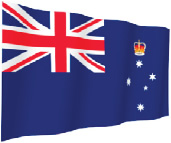
Victoria was the first state to have a flag. It was first flown in 1870 but dates back to 1865. As with all Australian state flags the Union Jack appears in the top-left corner of the Victorian flag. The Victorian badge, which appears alongside the Union Jack, features the five white stars of the Southern Cross below St Edward’s Crown.
Coat of Arms
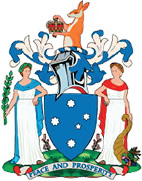
Victoria was the second Australian state to have a Coat of Arms after King George V gave his permission in 1910. The Victorian Coat of Arms is a blue shield picturing the five silver stars of the Southern Cross constellation. A Kangaroo holding a gold crown is depicted behind silver and blue twists (the colours of Victoria).
To the left of the shield is a figure representing peace. She wears a laurel crown and holds a sprig of olive. The figure to the right represents prosperity. She wears a circlet of wheat and carries a cornucopia (to symbolise plenty). Together the two figures represent the motto of Victoria: ‘Peace and Prosperity’. Victoria’s floral emblem, Pink Heath, sprouts from the ground at the base of the shield.
Emblems
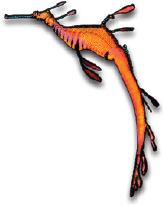
Victoria has four emblems: the floral emblem, bird emblem, animal emblem and marine emblem.
The floral emblem of Victoria was named as the Pink Common Heath in 1958. Victoria was the first Australian state to officially recognise a floral emblem.
The bird emblem of Victoria is the Helmeted Honeyeater. The Helmeted Honeyeater is one of 170 species of the honeyeater birds that inhabit Australia.
The animal emblem of Victoria is the Leadbeater’s Possum. The possum is an endangered marsupial that was thought to be extinct from 1909 until 1961 when it was rediscovered.
The marine emblem of Victoria is the Common Seadragon. The sea creature is delicate and graceful, perfectly depicting the seagrass that it inhabits.
Victoria attractions
Victoria is home to beautiful landscapes, from underground caves to impressive coastlines and captivating mountain ranges. Its capital city, Melbourne, is a teeming metropolis with intriguing laneways, shops, cafes and city sites.
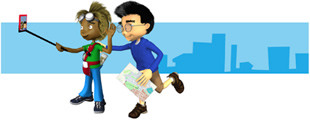
The Great Ocean Road
One of Victoria’s most exciting natural icons is the Great Ocean Road. The Great Ocean Road is a 243 km stretch of National Heritage listed road that runs along Victoria’s coastline from Torquay to Warrnambool. It offers fantastic surf, rainforests and wildlife, as well as remarkable sites such as the Twelve Apostles.
The Twelve Apostles rise from the ocean along a rugged section of coastline where the limestone cliffs have been worn away by powerful waves to form canyons, arches and pillars of rock.
The Melbourne Cricket Ground
The National Heritage Listed Melbourne Cricket Ground (MCG) is one of the city’s most iconic locations. The MCG was built in 1853 when the Melbourne Cricket Club had to move from its old location due to a steam train line being built over the oval.
Over the years, a total of eighteen grandstands have been erected at the MCG. It has been host to international cricket tests, Australian Football Grand Finals as well as the 1956 Olympic Games and the 2006 Commonwealth Games. Aside from cricket and Australian Football, soccer matches, rugby matches and even music concerts have been held at the MCG.
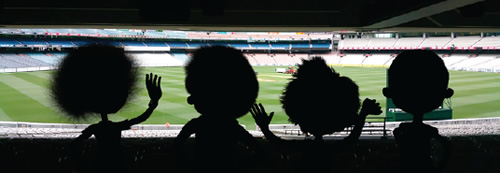
Victoria fast facts
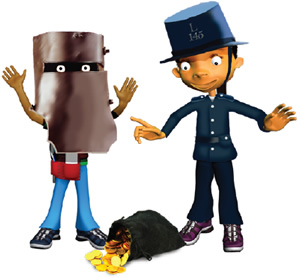
- Victoria is often referred to as the ‘Garden State’. The Australian Mint’s Note Printing Branch, located in Melbourne, developed and printed the world’s first plastic banknotes.
- Many talented film stars call Melbourne home including Liam and Chris Hemsworth, Isabel Lucas and Cate Blanchett. It is also the location for filming of one of Australia’s longest running TV shows, Neighbours.
- The Victorian town of Ballarat holds claim to the world’s largest alluvial (above ground) gold nugget named ‘The Welcome Stranger’ which weighs approximately 70 kilograms.
- The bushranger Ned Kelly is one of Australia’s most renowned figures. He was born in 1855 in Beveridge, Victoria to Irish Catholic parents. He was arrested and later hung at Melbourne gaol on 11 November 1880.
- Melbourne’s well-known tramway system has 244 km of track and more than 450 trams. It is the fourth largest tramway system in the world and the largest outside of Europe.
- Victorian scientist Dr David Warren was the first person to think of and develop the Black Box flight recorder. Fitted to all Australian airliners, it records the voices and instrument readings in the cockpit of an aeroplane, providing valuable information in air crash investigations.
- The iconic ute (utility vehicle or coupe utility) was first made by Ford Australia at their Geelong plant in Victoria in 1934.
References
The following links will direct you to the homepage of the websites used as references for this topic.
- Australian Bureau of Statistics: www.abs.gov.au
- Melbourne, Australia: www.visitmelbourne.com
- Victorian Government: www.vic.gov.au
- australia.com: www.australia.com




